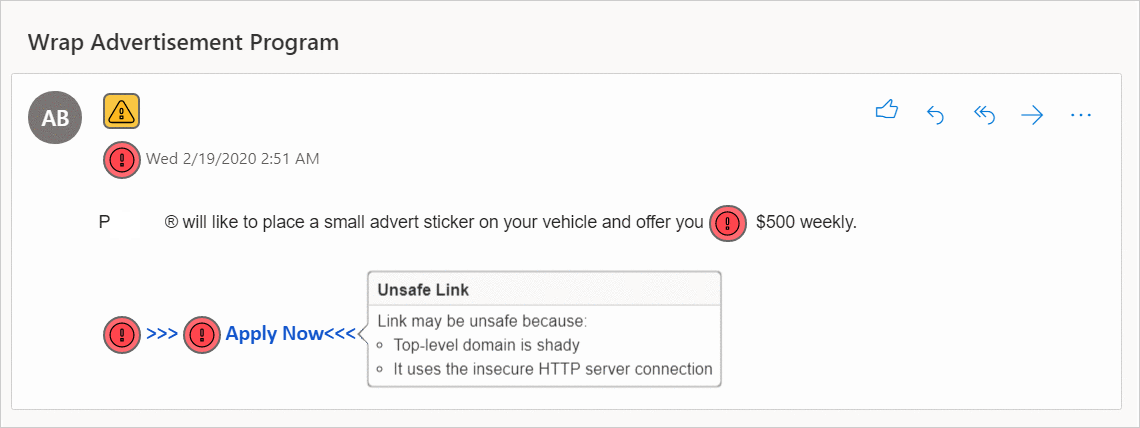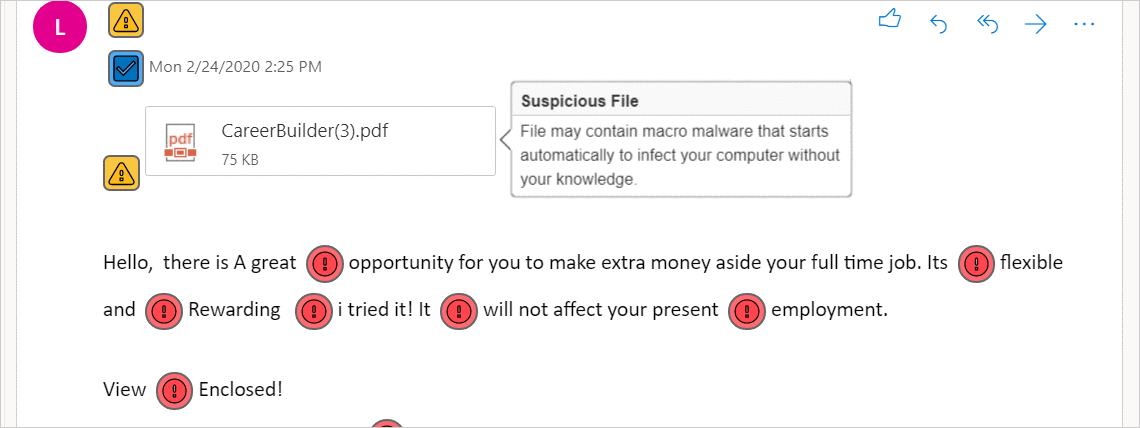# Hamspam
Hamspam is a browser extension that injects visual feedback about suspicious emails into your page.
## Preview
Hamspam scans for malware [checkpoints](#checkpoints "checkpoints") and marks all vulnerabilities with color-coded icons:
| Icon | Severity |
|-|-|
 | Low |
| Low |
 | Medium |
| Medium |
 | High |
| High |


## Getting Started
### Prerequisites
* Node.js
```
$ yum install nodejs
$ yum install npm
```
* Install npm packages
```
npm install
```
### Development
* Watch for updates to code and compile automatically: `npm run develop`
* Build the optimized production: `npm run build`
* Run all unit tests: `npm run test`
### Usage
1. Create a class that extends AbstractEmail and another class that extends AbstractView.
2. Define those new classes in [Lib.ts](src/Lib.ts "Lib.ts")
```
export * from './';
export * from './';
```
3. Add a configuration in [config.yaml](dist/config.yaml "config.yaml")
```
email:
- {name: , hostname: , view: }
```
#### AbstractEmail
##### Checkpoints
| Checkpoint | Method | Return | Description |
|-|-|-|-|
| Sender | `isTrustedSender( sender)` | `bool` | Checks if sender's address is in whitelist |
| Received timestamp | `deliveredLateNight( deliveryTime)` | `bool` | Checks if email was received overnight |
| Links | `isMaliciousLink( uri)` | `array` | Checks if a link is: - an http url
- an IP address
- a non-standard port (https over 80 and http over 443)
- authentication credentials
- a shady top-level domain
- a file path on local computer
- redirecting to another page
- containing - or %
- hosted on a free web hosting provider
|
| Attachments | `isSuspiciousFile( filename)` | `bool` | Checks if an attachment is: - an executable file that may contain malicious code
- script or command file
- a pdf and MS Office that may contain macro malware
|
| Spam words | `findSpamWords( test)` | `array` | Searches for every spam word and its start and end position. Built-in text recognition: - converts emoji to text description to detect spam words
- detects spam words in an image
|
##### Parsing
| Method | Return | Description |
|-|-|-|
| `getBody()` | `object` | Container of email body |
| `getSender()` | `object` | Container of sender's email address |
| `getSenderString()` | `str` | Sender's email address |
| `getDeliveryTime()` | `object` | Container of received timestamp |
| `getDeliveryTimeString()` | `str` | Received timestamp |
| `getLink()` | `array` | All links |
| `getLinkString()` | `array` | All link texts |
| `getAttachment()` | `array` | All containers of attachments |
| `getAttachmentString()` | `array` | All filenames |
#### AbstractView
To use your own icons, override `getIndicator()` and `getIndicatorClass()`.
| Method | Return | Icon Positon |
|-|-|-|
| `showIfIsTrustedSender( position, isTrustedSender)` | - | Sender's email address |
| `showIfDeliveredLateNight( position, deliveredLateNight)` | - | Received timestamp |
| `showMaliciousLink( position, maliciousLinkType` | - | Each link |
| `showSuspiciousFile( position, isSuspiciousFile)` | - | Each attachment |
| `showSpamWord( triggerWord)` | `str` | Each spam word |
#### Configuration
##### email
- `name`: child class of AbstractEmail
- `hostname`: the last part of the email address that comes after the at sign
- `view`: child class of AbstarctView
##### sender-whitelist
Whitelist of email addresses.
Using regular expressions: `\*@\*.email.com` will whitelist all email addresses ending with @email.com and @sub.email.com
##### late-delivery
- `from`: starting time of overnight hours (default: 300=5am)
- `to`: ending time of overnight hours (default: 1320=10pm)
Increase by 60 every hour after midnight. 0=midnight, 1=0:01am, 30=0:30am, 60=1am, 720=noon, 780=1pm
##### suspicious-file-extensions
Blocked attachment file extensions.
##### spam-words
Blocked words and phrases.
Using regular expressions:
- `gift( card)?` = gift, gift card
A blocked term is insensitive to blank spaces:
- `sign up` = signup (0 space), sign up (1), sign up (2)



